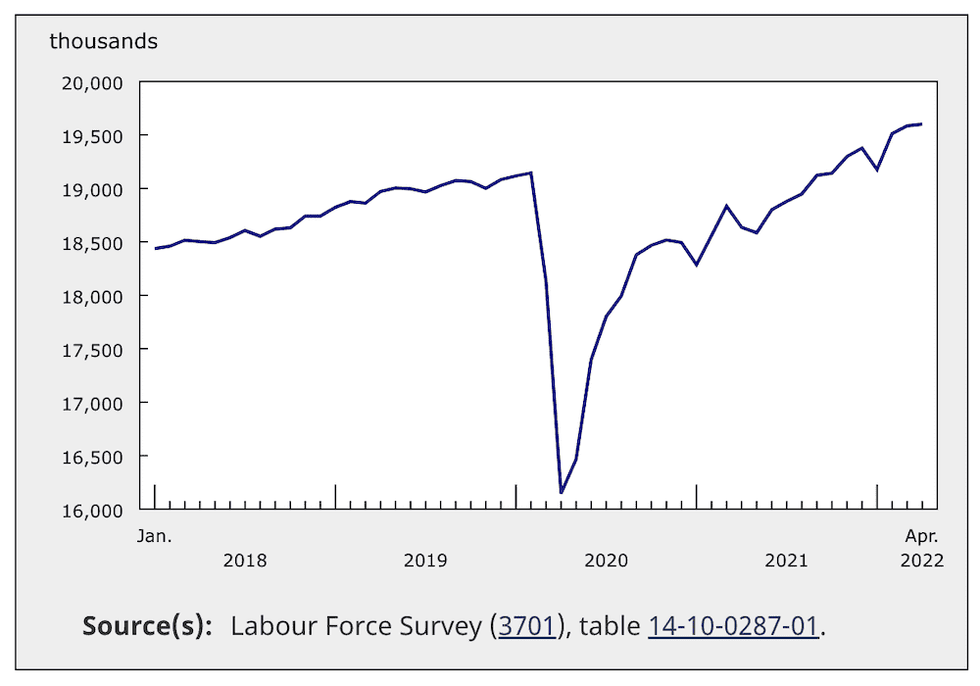After two consecutive months of booming gains, the Canadian jobs market held relatively steady between March and April, resulting in unemployment hitting a new record low of 5.2% -- down 0.1% from March. The overall labour market picture remains considerably stronger than pre-pandemic levels.
The latest data from Statistics Canada (StatCan) reveals the employment rate remained relatively unchanged last month at 61.9%. A total of 15,300 jobs were added to the economy, less than half of the 40,000 initially anticipated, putting an end to two consecutive months of surging growth.

Fifth Wave Leads to More Sick Days Taken
A contributing factor, StatCan points out, is the total number of hours worked dipped 1.9% over the course of the month due to illness or disability; that’s 2% higher than the 2017-2019 April average, and among the highest recorded over the course of the pandemic, indicating more workers were more frequently out sick as cases spiked following the removal of capacity limits on most businesses. The Good Friday holiday and a greater number of vacation days taken also contributed to the slower pace of growth.
“A number of signs have pointed to an increasingly tight labour market in recent months,” writes StatCan. “In addition to increases in full-time work, one aspect of this tightening has been a decrease in the proportion of part-time workers reporting that they would prefer full-time employment. The involuntary part-time employment rate fell to 15.7% in April 2022, the lowest level on record. The involuntary part-time rate had been elevated over the first 18 months of the pandemic, and peaked at 26.5% in August 2020, as many workers faced challenges securing full-time employment.”
Tightness in the labour market is yet more rationale for the Bank of Canada to aggressively hike interest rates in the months to come, in order to help balance the employee demand and jobs supply imbalance that has steadily grown over the course of the pandemic.
The greatest job gains was seen among the 25-54 age group, with an unemployment rate of 4.3%, the lowest since 1976. The data also reveals job gains were the strongest among women, rising 0.7% with 43,000 positions, while jobs for men declined by 0.5% (36,000).
The most jobs were added in the professional, scientific, technology, and public service sectors, with the greatest increases in New Brunswick, Nova Scotia, Newfoundland and Labrador, and Alberta, while Quebec experienced the greatest downturn. While the number of full-time positions remained relatively unchanged from the previous month, part-time positions -- those working less than 30 hours a week -- rose 1.3%, with 47,000 added to the workforce.
Notably, it was the construction sector that saw the largest decline as reported by Statan, with jobs down 1.3% (21,000), with losses concentrated in Quebec at 5.1% (16,000). That’s followed by a 0.9% decline in the retail sector (22,000).
READ: More Than 15,000 Construction Workers in Ontario Just Went on Strike
The average hourly wage also rose 3.3% (a grand total of $0.99), to $31.06, similar to the growth seen in March.
The national data agency also had fresh numbers on shifting trends in the post-pandemic workforce, finding the number of Canadians working exclusively from home declined by 24.3% from January as workplaces open back up and employers mandate return-to-office plans. They also report that the number of those in hybrid work arrangements was 5.8% -- fairly consistent with March levels, but has been on the rise in months prior.





















